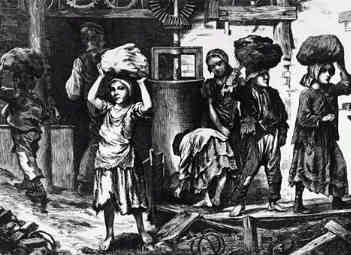
At the beginning of the 18th century, 90% of the population of Scotland lived in a rural environment. By 1900, one in three Scots was living in four cities (Aberdeen, Dundee, Edinburgh and Glasgow) and only around 11% were working on the land. This change can be largely attributed to the Industrial Revolution.
The Industrial Revolution brought with it the factory system. Workers were gathered together and organised in a new working organization. Factories operated twelve hours a day, 5-6 days per week. Obviously, there was little time off. This was in sharp contrast to agricultural work in the early 18th century when, it has been estimated, labourers worked an average of only 220 days a year. The rhythm of the seasons was replaced by the rhythm of the water wheel and the steam engine. Industrial relations were formalised by legally enforceable contracts and the division between master and worker became more acute.
Factory owners liked Scotland since wages there were consistently lower than those in England. In part, this was achieved through the more extensive use of female and child workers than in England. Pauper children were particularly used when there was an initial reluctance among workers to enter the new regimented workplaces. Women and children were of prime importance in the mines (see picture above), where they were used to transport coal to the surface until the 1842 Mines Act prohibited their employment. Altogether women, youths and children comprised almost two-thirds of the manufacturing workforce in the early 19th century. Factory Acts from 1833 onwards limited the working hours of children, and from mid-century the changeover from textiles to heavy industry meant that women were increasingly excluded from the industrial workplace. The exception was Dundee where the jute industry continued to employ large numbers of both single and married women. (Such as Mary Ann Wighton)
Great wealth came to the owners, who enjoyed, in late Victorian and Edwardian times, life-styles enviable for leisure and luxury. Unfortunately, in the presence of great riches, industrial workers lived lives governed by low wages, long hours and frequently unhealthy and dangerous working conditions. Away from the workplace, living conditions were a national disgrace. Housing, whether provided by employers or by builders planning to draw rents, was generally cheap in construction, poor in quality and grudging in space. If employers had provided high-quality housing, then their profits would have suffered. If builders had offered high quality rented homes, a low-paid workforce could never have paid the rents required. So, buildings were crammed into confined sites, often cheek-by-jowl with colliery and yard, factory and foundry; rooms were small, and around 53% of families, no matter how numerous, lived in houses with one or two rooms. Indoor sanitation was absent or shared, and the effect of these conditions upon the health and life-expectancy of the people was bound to be damaging. Infectious diseases spread rapidly. In 1832, cholera killed 10,000 with further epidemics in 1848, 1853 and 1866. Epidemics of diphtheria and scarlet fever were virtually annual, and tuberculosis killed thousands.
High mortality rates were not confined to epidemics: between the start and middle of the 19th century Glasgow's death rate more than doubled with over 50% of deaths being of children under five. The cities were particularly lethal places to live with mortality rates in the 1860s nearly 60% higher than in rural Scotland. Increased death rates during economic recessions reveal that poverty played a role as well. (About 70% of the workforce were considered lower skilled or unskilled and commonly earned less than £50 a year. Poverty led to malnutrition, and diseases caused by diet deficiency, like rickets, were common. To make matters worse, the houses were themselves aging, and new building was quite inadequate to provide homes for the rising population between 1850 and 1900.
By the mid 19th century, local government could no longer ignore the problems of urbanisation. Epidemics affected all classes of society, not just the poor. The statutory registration of births, marriages and deaths from 1855 meant that information was available on causes of death and public health could be more comprehensively assessed. The cities led the way in tackling public health issues by establishing sanitary departments and appointing Medical Officers of Health.
The Industrial Revolution brought economic prosperity to Scotland but its impact was felt above all through social transformation. Industrialisation brought new employment and new styles of working. It caused sweeping population movement as jobs became increasingly concentrated in the central belt, putting pressure on urban infrastructure and giving rise to new government legislation. Scottish society became more complex and more unstable, and reform was sought through political action. By 1900 Scotland had emerged as a modern, industrial nation.
Sources
Smout, T.C., A history of the Scottish people. Fontana Press:1998
Various websites, including:
Scotland: A concise history. (http://www.electricscotland.com/history/scotland/chap9.htm)
The impact of the Industrial Revolution in the 18th and 19th Centuries. (Kirsty Wilkinson) (http://www.lifelong.ed.ac.uk/news/essays/wilkinson.html)